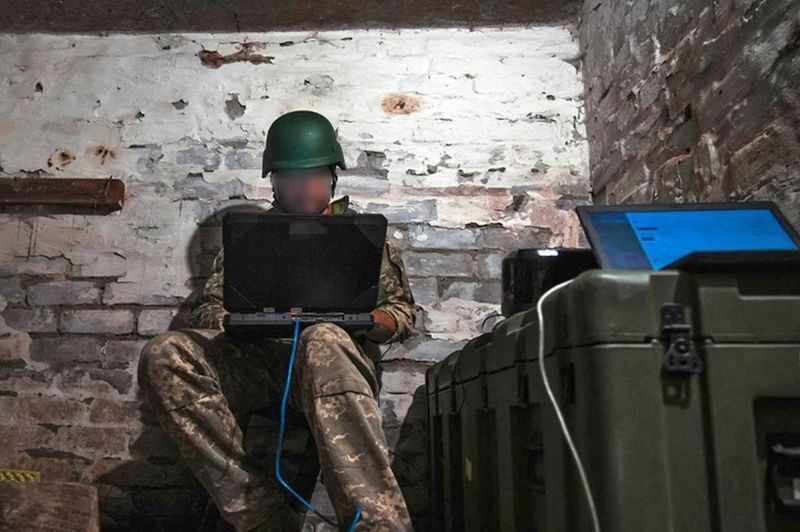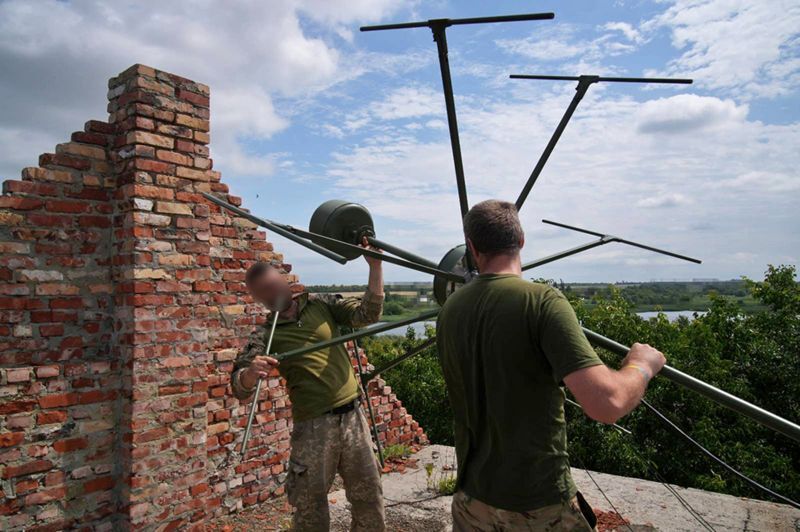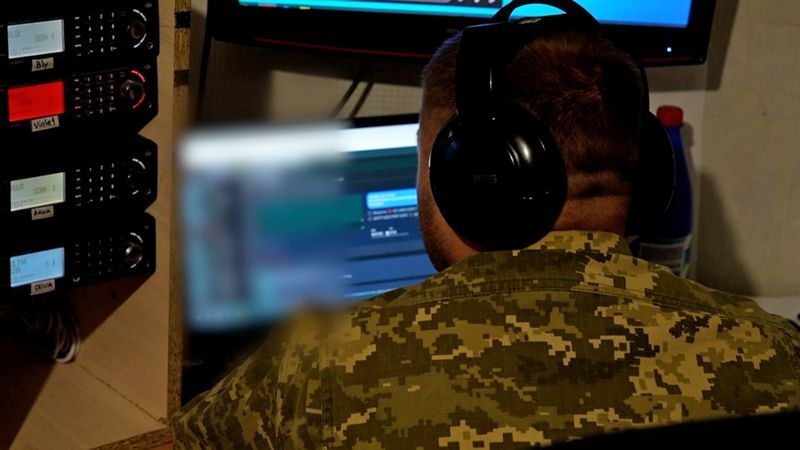By Abdujalil Abdurasulov
BBC News, Kyiv

In the early days of the invasion of Ukraine, experts were surprised at how poorly the Russian army’s electronic warfare units performed. But nearly 18 months later they are causing significant problems for Ukraine’s counteroffensive.
“Use single rounds,” whispers a Ukrainian soldier hiding behind a wall near the eastern front line. “This way we will be able to last till the morning [if they come closer].”
The soldier’s call-sign is Alain Delon, like the famous French film star of the 1970s. And like something from a spy movie, he is part of a lightly armed team of electronic intelligence officers – a high-priority target for the Russian army.
Alain fears Russian troops may have spotted their antenna and started heading for their base. He decides to change position. The key in electronic warfare is being invisible to the enemy.
Their job is to detect electronic signals from all kinds of Russian weapons – including drones, air defence systems, jammers, artillery, and multiple rocket launchers. They work out where the signals originate and the type of weapon, then pass on coordinates to other units that will aim to destroy the target.

This is a war of technologies
Col Ivan Pavlenko
Ukraine electronic and cyber warfare department
The information also helps commanders build up a picture of the battlefield.
“This is a war of technologies,” Col Ivan Pavlenko, chief of the Ukrainian General Staff’s electronic and cyber warfare department, tells the BBC.
“If I see a number of radio stations in the same place, I understand it’s a command post. If I see some radio stations begin to move forward, I understand it could be a counter-offensive or an offensive.”
This is an invisible conflict carrying on in parallel with the explosions, missile strikes and trench warfare that dominate the news.
Almost every modern weapon – from artillery installations to high precision missiles – uses radio waves, microwaves, infrared or other frequencies to receive data. This makes them vulnerable to electronic warfare, which aims to intercept and suppress those signals.
“If you’re losing in electronic warfare, your forces will turn into a 19th century army,” says Yaroslav Kalinin, chief executive of Infozahyst, a company that produces electronic warfare systems for the Ukrainian army. “You will be 10 steps behind your enemy.”

In recent years Russia has developed a range of jamming technology. This includes:
– Krasukha-4, which targets airborne and air defence radars
– Zhitel, which supresses satellite signals
– Leyer-3, a cellular and radio communications jammer
By the time of the full-scale invasion in February 2022, Russia had 18,000 electronic warfare troops, Col Pavlenko says.
But the effect was less impressive than many had expected.
“They were trying to break down our radars, to penetrate our air defence systems,” says Yaroslav Kalinin. “They were partially successful at this, but not completely.”
Ukrainian air defence systems were still able to shoot down Russian jets.
Russia’s lack of air supremacy contributed to its failure to capture Kyiv quickly.
Russian forces also failed to shut down communications, which allowed the Ukrainian military to organise their defences. Although some military satellite networks were jammed, cellular and internet communications were largely unaffected.
When Russian troops were advancing towards Mykolaiv in February 2022, villagers used mobile phones to tip off the Ukrainian military about the movement of Russian columns.

Expecting a walkover, Moscow may have thought they wouldn’t need to fully deploy electronic warfare systems. But Bryan Clark, a senior fellow at Hudson Institute, a US think tank, says another problem was that electronic warfare units couldn’t keep up with the rest of the troops.
“Russian systems are large unwieldy, vehicle-borne systems that are designed to be on the defensive,” he says. “And as a result, their electronic warfare systems weren’t very agile, they weren’t very fast and they weren’t very numerous.”
But Russia has learned from its mistakes, he says. Instead of using large equipment that can be easily spotted and destroyed, it is now increasingly relying on smaller, more mobile devices.
Bryan Clark says Russia has managed to deploy hundreds of mobile electronic warfare units along the front line in an attempt to slow down Ukraine’s counter-offensive. These range from GPS jammers to systems that suppress radar and prevent US aircra identifying targets for Ukraine to attack.
Russian systems such as Zhitel and Pole-21 are proving to be particularly effective to jam GPS and other satellite links. They can disable drones that direct artillery fire and carry out kamikaze attacks on Russian troops.
Many of the sophisticated weapons provided to Ukraine by Nato countries are vulnerable to such jamming too because they use a GPS signal for navigation.

“Zhitel can jam a GPS signal within 30km of the jammer,” says Mr Clark. “For weapons like [US-made] JDAM bombs, which use just a GPS receiver to guide it to the target, that’s sufficient to lose its geolocation and go off target.
The same applies to the guided rockets fired by the Himars multiple rocket system, which made a big contribution to Ukraine’s successful offensives last autumn.
Both sides have been trying to develop counter-measures against each other’s jamming, including reprogramming weapons.
Bryan Clarke describes it as an intense competition of “move and countermove”.
Col Pavlenko does not deny that Russian systems can reduce the efficiency and accuracy of the weapons Ukraine has received from its Western partners. This just makes targeting Russian electronic warfare systems even more important, he says.
“Before we strike with a precision-guided munition, we have to provide intelligence. Is there any suppression in that area? If that area is affected by a jamming signal, we have to find the jammer and destroy it, and only then use this weapon.”
Since February 2022 Ukraine has destroyed more than 100 major Russian electronic warfare systems, he says. The BBC cannot independently verify these numbers.
Intelligence units like Alain’s work relentlessly to increase this number, by locating them.
Now at a new location, his team has intercepted radio communications between Russian soldiers, and they are listening in. It’s a conversation between Russian artillerymen. Alain’s team is now working to get their coordinates. In a war, he says, every bit of information can be important.
The article is available on BBC website.